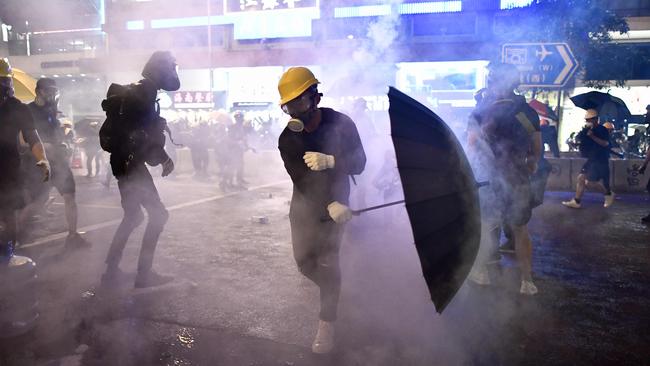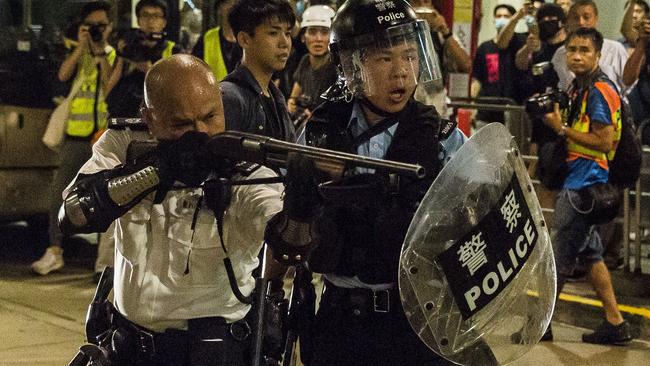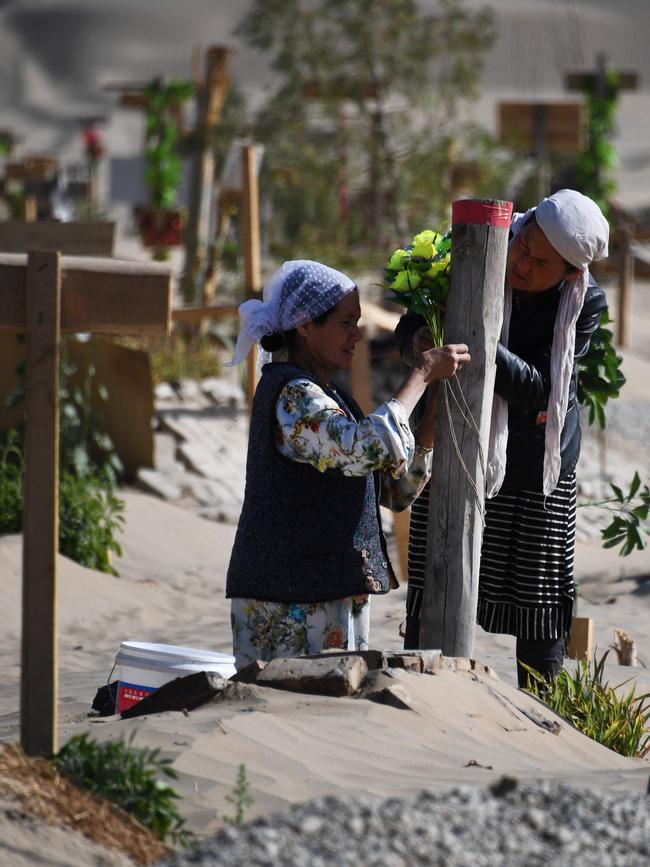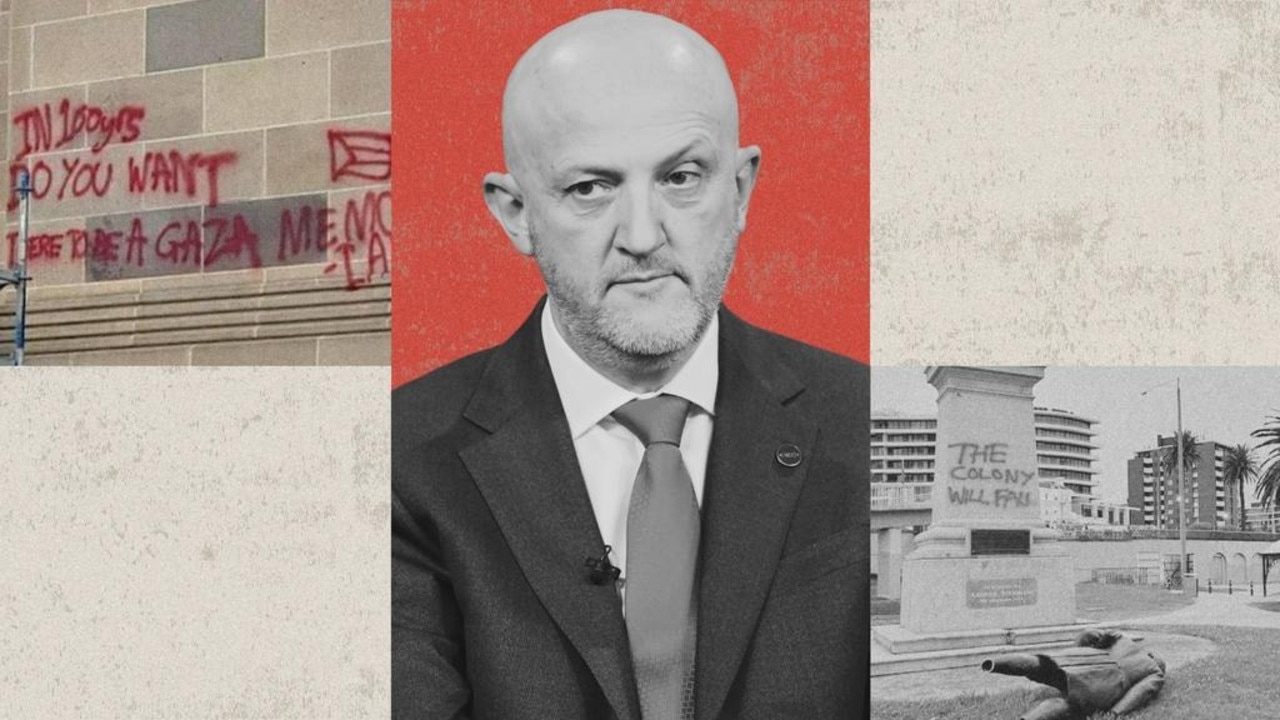Trouble brews on the borderlands
China’s strongman president Xi Jinping is reluctant to risk a bloody showdown in Hong Kong. But no one doubts there are limits to his patience.

One of the world’s greatest cities, Hong Kong, today feels like a town under siege. Its heady atmosphere now comprises a rare mixture of menace, excitement and the mundane.
Although China’s unstoppable leader, Xi Jinping, loves rolling the power dice, he’s reluctant to risk a bloody showdown in Hong Kong. Yet. But no one doubts there are limits to that reluctance. It’s just that the red lines are not clear.
Despite the White House’s recent worried warnings, the 6000-strong People’s Liberation Army garrison in the city remains in the barracks and the 19,000-strong People’s Armed Police parade in neighbouring provincial capital Guangzhou on Tuesday appears to have been primarily focused on rehearsing for the 70th anniversary of the People’s Republic of China on October 1 — albeit handily also sending a message to Hong Kong.

When Xi visited Hong Kong in 2017 for the 20th anniversary of its return to China, a proud military parade by the PLA garrison provided his unexpected centrepiece.
Xi’s “Thought on Socialism with Chinese Characteristics for a New Era” — now enshrined in the state and communist party constitutions, contrasting today’s New Era with Deng Xiaoping’s old one — champions purification, centralisation and unification. Xi has far less time than Deng for the dynastic property tycoons who continue to dominate Hong Kong’s business scene.
However, wresting direct control of China’s great southern special administrative region from its local bureaucracy and police force would end its autonomy under the “One Country, Two Systems” formula under which Britain had returned it to Beijing’s rule.
Outliers watching
Xi would clearly favour one country, one system. But he is already fighting on other major fronts, including the trade and tech wars with the troublingly unpredictable US President Donald Trump, steering the economy between the twin sinkholes of disastrous debt and stagnation, and the demographic shadow threatening that China may yet grow old before it grows rich.
The big trouble brewing in much of the PRC’s borderlands adds massively to these challenges. Such is the size of Xi’s shadow over China that success in any or all of them will be attributed to him. So will blame, if China falters.
Thus even the strongman leader of the most powerful organisation in the world needs to weigh the extent of his political capital — however huge — that he can afford to use up on imposing his will on sophisticated, cosmopolitan Hong Kong.
While those borderlands each have their own strikingly different identities and issues, the people there watch especially attentively what’s happening in China’s other outlying areas — which, for the most part, were incorporated into Beijing’s rule during the peak of the final, Manchu dynasty.
Xinjiang, the vast northwestern “autonomous region” twice the area of NSW, a vital stepping stone whose unconditional participation is needed for the success of Xi’s Belt and Road Initiative, has remained in virtual lockdown since Beijing moved Chen Quanguo there as party secretary in 2016, after five years keeping Tibet in its place in the same role.
In recent years it has become very difficult for both Uighurs and Tibetans to travel within China — with hotels frequently refusing to accommodate them. The UN says more than a million of the Muslim Uighurs — who have rapidly become a minority in their homeland, now about 40 per cent of Xinjiang’s population — have been consigned to “re-education camps”, with parents split from their children.

Beijing, which is formidably weaponising its economic heft, especially through its multi-billion-dollar BRI, demonstrated its determination to press on with its controversial measures in Xinjiang when it obtained last month the supportive signatures of 37 governments including — in this region — Myanmar, North Korea, Cambodia, Laos, The Philippines, Pakistan, Tajikistan and Russia, in response to a letter signed by 27 countries including Australia, Japan and New Zealand expressing concern.
Xi’s determination to “Sinicise” all religions in China — including Islam and Christianity, whose followers are starting to exceed the 89 million Communist Party members — is perceived as an especially existential threat to Tibetan Buddhism, widely viewed in China as the most authentic strand of the religion. Thousands of nuns, monks and other adherents have been removed in recent months from the massive Tibetan Buddhist study centres of Yachen Gar and Larung Gar in the Tibetan enclave of Sichuan province.
Core party precepts
Xi’s path to power was paved substantially by his vows to purge and purify the party, whose corruption was beginning to risk its popular legitimacy, and to unify the nation as did Mao Zedong. He urged the party, at its most recent national congress, in 2017, “to staunchly oppose all attempts to split China or undermine its ethnic unity and social harmony and stability”.
Xi wrote last year that the party “should be constantly nourished by the wisdom of Marxist philosophy and apply dialectical materialism”. That unity and that materialism are challenged most palpably in the borderlands, where Xinjiang’s Uighur Muslims and Tibet’s Buddhists remain loath to subordinate their religious adherence to the Communist Party’s preferred focus on economic prosperity. During a visit I made to Tibet, a yak herder turned entrepreneur with the single name Tsidanduo showed me his elaborate Buddhist prayer room on the top floor of his spacious home. While enthusing about the opportunities brought by Beijing, he insisted that spiritual life “is different from the material life”.
Those core party precepts of unity and materialism are also challenged in Hong Kong — where young people have demonstrated zealously and persistently that despite former misperceptions among austere Chinese mandarins chiefly from the country’s north, the Chinese people of the south are not readily placated by being encouraged to focus on making money.
They value especially highly the rule of law — the unique independence, within the People’s Republic, of their courts — and increasingly also seek to be represented adequately in their own governance.
The most elusive of those borderlands, Taiwan, has over the past 30 years, since it shed its cruel one-party military rule, grasped democracy and open governance with striking enthusiasm.
Even Taiwan’s Kuomintang, or Nationalists, the former “big sister” party under which China’s communists originally developed, no longer views One Country, Two Systems as an option holding any appeal for the island’s acceptance of control by the People’s Republic — especially as they watch agog the events unravelling in Hong Kong for which the formula was originally applied.
Yet Xi stressed earlier this year that China’s “sacred mission of unification” could no longer be left to future generations. His own personal reputation would be cemented if he could bring Taiwan, with a similar population to Australia, into the fold. Shen Dingli, professor of international studies at Shanghai’s Fudan University, says this would make Xi “the greatest leader in the Chinese Communist Party’s history”.
The growing links between democrats in Taiwan and Hong Kong threaten to make that prospect, and China’s unification under a single strong party, even more difficult.
Palpable spillover
In 2014, Taiwan’s students halted an enhanced economic deal with China that had been negotiated by Kuomintang president Ma Ying-jeou, through protests in the parliament dubbed the Sunflower Movement. This success helped inspire the Umbrella Movement among students, demanding universal suffrage, which in turn brought Hong Kong to a standstill.
Today that spillover is even more palpable. About 30 Hong Kong protest leaders are reported to have sought refuge in Taiwan, which has been approving growing numbers of migrants from the city of 7.4 million. The Heavenly Book of How to Migrate to Taiwan is now on sale in Hong Kong, its prime market.
Xi will have hoped that Taiwan’s presidential and parliamentary elections next January 11 would see the Kuomintang sweep back into power — led now by the populist Han Kuo-yu, who last year grabbed from the Democratic Progressive Party the mayor’s position in Kaohsiung, the country’s second city and capital of the DPP’s southern heartland. But the protests in Hong Kong — where the focus is evolving from the now-suspended law enabling extradition to mainland China towards seeking to improve the city’s overall governance — are pushing the Taiwan polls back towards incumbent President Tsai Ing-wen, whose DPP is viewed by Beijing as harbouring an intent to declare the island formally, as well as de facto, independent.
By no coincidence, the US reached out last month to Taiwan, approving a new round of $3.2 billion in arms sales and hosting two brief visits by Ms Tsai. At the same time, Beijing pushed Taiwan further away, halting visits there by individual Chinese tourists.
Thus while Xi has proclaimed, channelling the ancient Chinese precept of tianxia, that “all under heaven are one family,” it’s clearly a fractious family.
This is particularly palpable in Hong Kong right now. There last week, I visited one of the city’s celebrated “Lennon walls” — named after the wall in Prague that, after John Lennon was shot in 1980, was filled with Post-it notes and pictures pondering both local and global causes.
In Tai Po, towards the mainland border, all the walls of the long tunnels leading to the subway station are filled, floor to ceiling, with comments criticising Hong Kong’s unpopular chief executive Carrie Lam — photos of her were attached to the floor too — and calling for many changes in the region’s governance.
The faces on a massive poster of politicians deemed to be governmental rubberstamps were crossed out. A week before, this Lennon wall had been entirely stripped overnight, it was said by 400 people bussed in from Shenzhen, just over the border. But thousands of local people had restored it with a vengeance.
Concern for rule of law
Lam had believed — and presumably convinced Beijing — that the Umbrella Movement was consigned to the past, with its leaders jailed or banned from taking seats they had won in the legislature. While democracy movement leaders had attempted to foster support for protests against, for instance, letting mainland security forces police the platforms of the new high-speed rail terminal into China — and Beijing in nine hours — they failed to gain real traction.
The extradition issue, however, touched a universal nerve — concern for the rule of law — with the business community including many leading mainland Chinese entrepreneurs anxious about its potential impact, as well as artists, lawyers themselves, academics, and Hong Kong’s lively Christian community.
The night before a major demonstration, I sat by coincidence next to a group of tables at a cheap restaurant that were commandeered by a large crowd of Hong Kong students wearing black T-shirts with texts from St John’s gospel on the back, discussing their participation the next day — when I saw demonstrators whose shirts bore the name of the ubiquitous anthem of the protests: Sing Hallelujah to the Lord.
A reporter friend prepared to cover the event by donning the kit of white hard-hat, goggles, anti-tear-gas mask and fluoro vest, that she had been given as a member of the Hong Kong Journalists Association. Many reporters have complained that the Hong Kong police — who have appeared to act at times as a tribe of their own — have targeted journalists.
China’s Hong Kong and Macau Affairs Office has claimed that “external interference” — implying specifically the US “black hand” — lies behind such events. But this and warnings from China Daily that “external forces” wish to instigate democratic “colour revolutions” as in Ukraine, North Africa and elsewhere, are shrugged off in Hong Kong and the other borderlands.
Such claims have more currency with the essentially intended audience within China, where information about challenges to PRC unity is more stringently policed than any other topic.
Wu Qian, China’s Defence Ministry spokesman, highlighted as especially “intolerable” the protests against China’s liaison office in Hong Kong that included the defacing by black paint of the official emblem.
From the Hong Kong side, the Umbrella Movement student leaders complain their attempts to participate in formal governmental processes since then have been effectively rejected by the authorities. But two of the best-known young politicians, Joshua Wong and Nathan Law, have told me they still believe time is on their side, since they intend to focus on engineering a better deal for Hong Kong when the 50 years of One Country, Two Systems ends in 2047 — when they will still only be 50 and 53 respectively.
‘Huge political cost’
The train of events in Hong Kong is hard to predict from here. Xi would simply like the protesters, as with all China’s troubled periphery, to pipe down, keep quiet and focus on benefiting from their opportunities to prosper.
The PLA, which took decades to restore its popular reputation following its deployment to Tiananmen Square in 1989, is pleased to let the Hong Kong police bear the brunt of the protests and of popular animosity.
Hu Xijin, the editor-in-chief of China’s nationalist Global Times, posted this week that sending in the army would come at “huge political cost”.
He added: “Once the PLA has taken charge of the situation and quelled the riots, what’s next?” He described the garrison as the symbol of national sovereignty, “not a fire brigade for law and order”. As for dour but bewildered chief executive Carrie Lam, she has clearly lost the “mandate of heaven”, the right to rule, as reinforced this week by the arrival of Typhoon Wipha. Hong Kong, physically soaked and discomfited by the violent elements that have latched on to its protests, is quietly proud it is standing up for itself. The two million who marched in June have not changed their minds or backed down.
Australian corporate lawyer Antony Dapiran, a Hong Kong resident who is agog watching today’s events, concludes his Penguin book City of Protests by stating that Hong Kongers were transferred from British to Chinese rule, forgoing any opportunity for self-determination, but that through their protests they are now asking again and again: “What is Hong Kong’s place in this post-colonial world? Perhaps the protests will continue until Hong Kongers can answer this question for themselves.”
Rowan Callick is a former China correspondent and Asia-Pacific editor at The Australian.



